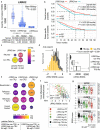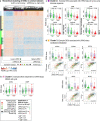Loss of Parkinson's susceptibility gene LRRK2 promotes carcinogen-induced lung tumorigenesis
- PMID: 33483550
- PMCID: PMC7822882
- DOI: 10.1038/s41598-021-81639-0
Loss of Parkinson's susceptibility gene LRRK2 promotes carcinogen-induced lung tumorigenesis
Abstract
Pathological links between neurodegenerative disease and cancer are emerging. LRRK2 overactivity contributes to Parkinson's disease, whereas our previous analyses of public cancer patient data revealed that decreased LRRK2 expression is associated with lung adenocarcinoma (LUAD). The clinical and functional relevance of LRRK2 repression in LUAD is unknown. Here, we investigated associations between LRRK2 expression and clinicopathological variables in LUAD patient data and asked whether LRRK2 knockout promotes murine lung tumorigenesis. In patients, reduced LRRK2 was significantly associated with ongoing smoking and worse survival, as well as signatures of less differentiated LUAD, altered surfactant metabolism and immunosuppression. We identified shared transcriptional signals between LRRK2-low LUAD and postnatal alveolarization in mice, suggesting aberrant activation of a developmental program of alveolar growth and differentiation in these tumors. In a carcinogen-induced murine lung cancer model, multiplex IHC confirmed that LRRK2 was expressed in alveolar type II (AT2) cells, a main LUAD cell-of-origin, while its loss perturbed AT2 cell morphology. LRRK2 knockout in this model significantly increased tumor initiation and size, demonstrating that loss of LRRK2, a key Parkinson's gene, promotes lung tumorigenesis.
Conflict of interest statement
The authors declare no competing interests.
Figures



References
-
- World Health Organization. Cancer key facts. https://www.who.int/news-room/fact-sheets/detail/cancer (2018).
Publication types
MeSH terms
Substances
Grants and funding
LinkOut - more resources
Full Text Sources
Other Literature Sources
Medical
Molecular Biology Databases

